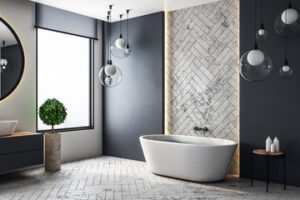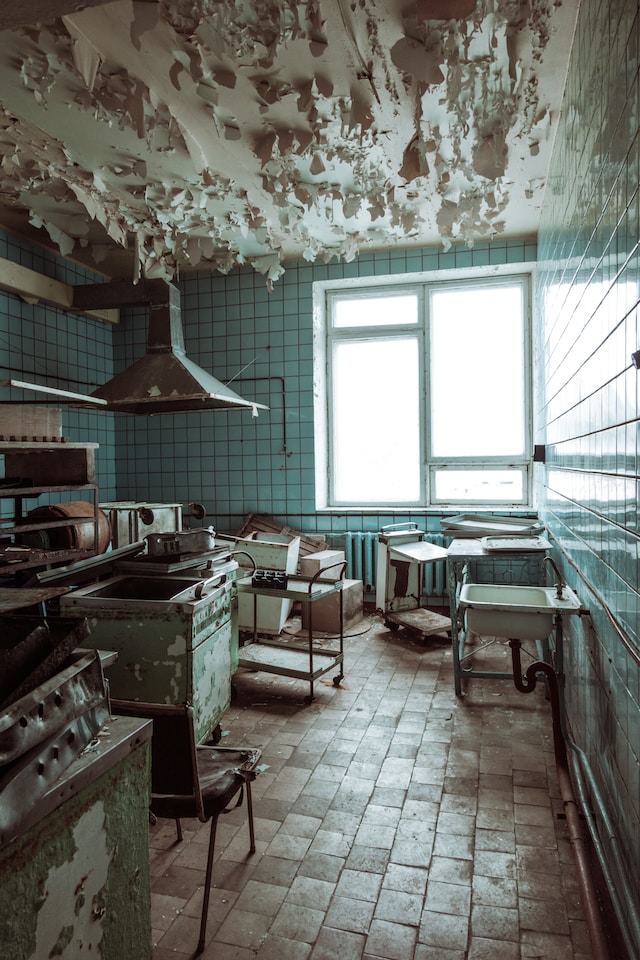Bathrooms should be a place to rest and refresh. But that doesn’t mean your bathroom can’t have some serious style.

Floating shelves can make a big statement in your bathroom. They’re minimally invasive but can be found in many different styles to suit your space’s aesthetic. They’re ideal in corners, nooks, over the toilet, on the back of a door, or any space where wall storage is desired.
Wooden options like reclaimed wood or barn board are great for rustic designs, while white finishes can create a sleek and minimalist look. Add decorative elements like greenery or vintage canisters to bring a unique twist to your floating shelf design. Stacking multiple items like wicker baskets or glass jars on each shelf is another creative way to style your shelving. Try staggering functional items, like Q-tips and cotton swabs in small jars, or even books, on each shelf to create an eye-catching display.
If you’re not a handy DIYer, you can also purchase pre-made wooden shelves. They’re often painted in a coordinating color to your walls, which helps them blend in without creating visual clutter. If you’d prefer a more natural wood look, you can stain the shelves yourself. Before staining, sand the surface of the wood to remove any rough spots. Then use a damp cloth to wipe away any sanding dust. Once the shelf is dry, apply a few coats of wood stain to your shelves. Then let the wood finish cure before using your new bathroom shelving.
Mixing Patterns
Choosing the right mix of patterns in your bathroom is key to a unique design. While a single pattern may seem like too much, incorporating several varying textures and designs can add an element of intrigue. For example, choose rough stone and smooth tile for contrast or play with different shades of the same color. The key is to make sure that the different colors or textures complement each other, not compete with one another.
If you’re not ready to take on a full-scale pattern, opt for a bold floor rug that features your preferred style. This will tie your room together without being too overpowering. Popular patterned bath rugs include herringbone, chevron, imperial trellis and quatrefoil patterns.
When it comes to mixing tiles, it’s important to remember that the size of the pattern will determine how well it pairs with other shapes and sizes. For instance, a small hex tile pattern might pair well with larger oblong tiles for a sense of balance. Similarly, mixing large-scale herringbone and smaller chevron patterns might work in your favor because they share the same dominant pattern.
When it comes to mixing tile patterns, it’s also a good idea to prioritize a color scheme for the entire room before you start. This will help you decide how many different types of patterns and shapes you can use in the space without creating visual clutter. Also, try not to combine multiple finishes, such as glossy and matte tiles. The contrasting materials can create an unbalanced look in your bathroom.
Rustic Wood
Rustic elements can be used in a modern bathroom design to create a look that’s both contemporary and comfortable. Wood is a popular choice for rustic designs and it can be used in almost any area of the room. Try adding a wood vanity, wall paneling, or even a floor made of reclaimed hardwood for a unique and earthy look. Using natural materials like clay in decorative accents is another great way to add a rustic element to your bathroom design.
If you have a more modern style house, integrating rustic elements into your bathroom design can be easier than you might think. You can use reclaimed wood to build a unique vanity or even cover walls in rough-cut lumber for an interesting contrast with smooth tile. Using natural stone for shower stalls and accents can also work well in any bathroom.
If you’re looking to add a bright showpiece to your bathroom, rustic style decor is a perfect choice. Using a bold color in a shower curtain, a decorative tile wall, or a simple piece of furniture can instantly grab attention and give your bathroom a unique, rustic look. A few rustic accents can really brighten up a room without overpowering it. If you don’t want to commit to a complete remodel, you can easily incorporate rustic accents with the addition of new linens and paint. This is a great way to update your bathroom without spending too much money.
Double Sinks
When it comes to bathroom design, double sinks make a lot of sense. Especially for bathrooms that are used by couples, two sinks mean that one person doesn’t have to worry about getting in the other’s way when trying to get ready.
Whether they’re side-by-side or built into a larger piece of furniture, dual vanity basins offer convenience and symmetry in any bathroom space. They can also add a more luxurious feel, which is ideal for master baths or guest bathrooms.
While many people think that a his-and-hers vanity is the only way to incorporate double sinks into their bathroom design, there are plenty of other ways to do it. For example, using an antique dresser or sideboard as a bathroom vanity can be an attractive option. Pairing it with a large mirror that spans the entire wall is an easy way to create a symmetrical layout.
In addition to creating a more convenient space for couples to share, a double sink in your master bath may also increase the resale value of your home. However, it’s important to be mindful of NKBA planning guidelines when designing your bathroom with two sinks to ensure that your home’s plumbing and electrical systems are up to code. In general, it’s best to avoid tucking in dual sinks next to each other because the proximity to each other can lead to overheating and moisture issues.
Texture
As the bathroom becomes a spa-like space for relaxation, textures that enhance tactile richness are on the rise. Natural materials like wood, stone, and even living plants boost visual appeal and create a grounding sanctuary.
A harmonious blend of sleek modernity with rustic charm is a top bathroom remodel trend for 2024. From contemporary vanities that showcase reclaimed wood to rustic light fixtures, this hybrid aesthetic is timeless and captivating. This design approach complements a new direction in bathroom styles that favors a more living room-like aesthetic.
Another interesting development in bathroom trends is a shift toward bold colors that are often reserved for living rooms and bedrooms. Rather than neutrals or pastels, homeowners are turning to bold shades like navy blue. The striking hue has a rejuvenating effect and is a fresh alternative to sage green or gray.
A more subtle way to add texture to the bathroom is by using a delicate raffia wallcovering. The woven material adds depth to the space and is an attractive contrast to a modern white vanity. Also resurfacing is the art deco-inspired Crittall window frame. The sturdy metal-framed structure was first introduced in the 1880s and has become popular again thanks to its versatility in modern bathrooms. It can be used to frame a shower screen or add visual interest above a freestanding tub. It also pairs well with metallic elements, a bathroom trend for 2024 that emphasizes brass and silver accents.
Accessories
Accessories are the finishing touches that can be the difference between a drab washroom and a stunning one. These little ornaments can be functional or purely decorative, but the best ones offer a bit of both. From floral stainless-steel toilet paper holders to painted bath trays, unique bathroom ornaments and accessories are the perfect way to elevate your space and add a touch of personality.
Shelves are one of the most important storage items in a bathroom design, and they can be used to display a variety of other accessories and decorative pieces. They also give the room a clean and spacious look. Another functional accessory is a set of robe hooks, which can be placed close to the shower or bathtub and are great for keeping clothes or hand towels within arm’s reach.
Soap dispensers are an excellent choice for storing liquid soap, and they can be bought in a wide range of materials and finishes. Generally, it is better to buy a matching set of bath accessories, such as a soap dish and toothbrush holder, in order to create a cohesive aesthetic for the space.
Adding the right accessories can transform a boring bathroom into a relaxing oasis that is sure to leave guests impressed. If you are not quite sure what to do with your bathroom, contact a design professional for help. They can suggest a few different options and help you select the perfect accessories for your home.

